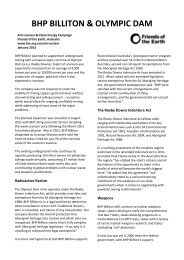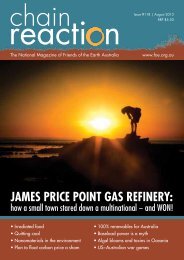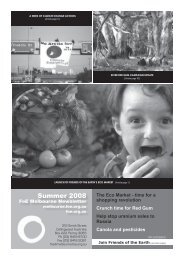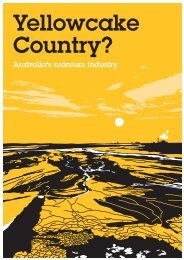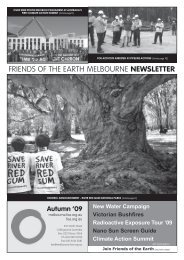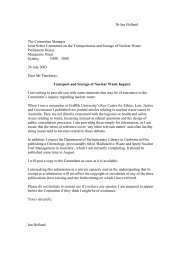Thirty Years of Creative Resistance - Friends of the Earth Australia
Thirty Years of Creative Resistance - Friends of the Earth Australia
Thirty Years of Creative Resistance - Friends of the Earth Australia
Create successful ePaper yourself
Turn your PDF publications into a flip-book with our unique Google optimized e-Paper software.
In <strong>the</strong> early 1990s, <strong>the</strong> nuclear industry<br />
started to make public its plans for a long<br />
term storage site for radioactive waste,<br />
not only from <strong>Australia</strong>’s research reactor<br />
at Lucas Heights, but also from nuclear<br />
reactors around <strong>the</strong> world. This issue<br />
simmered for <strong>the</strong> next decade, until plans<br />
by a company called Pangea Resources<br />
to locate a high level radioactive waste<br />
dump in <strong>Australia</strong> were leaked to FoE in<br />
England and <strong>the</strong>n to FoE and o<strong>the</strong>r NGOs<br />
in <strong>Australia</strong>. This premature release <strong>of</strong><br />
Pangea’s plans lead, soon afterwards, to<br />
<strong>the</strong> company closing its <strong>of</strong>fice in <strong>Australia</strong>.<br />
In terms <strong>of</strong> <strong>the</strong> national waste facility, both<br />
ALP and Coalition governments moved<br />
forward with plans for a low and medium<br />
level waste dump. In 1994, <strong>the</strong> Federal<br />
Government released a discussion paper<br />
outlining a selection process for <strong>the</strong><br />
physical location <strong>of</strong> <strong>the</strong> waste facility. It<br />
identified eight possible locations. FoE and<br />
<strong>the</strong> ACF worked relentlessly to slow <strong>the</strong><br />
process, using procedural intervention and<br />
external opportunities to highlight <strong>the</strong> flaws<br />
in <strong>the</strong> proposal, and calling instead for onsite,<br />
above ground storage <strong>of</strong> wastes.<br />
Through his time as co-ordinator <strong>of</strong> <strong>the</strong><br />
FoE Melbourne anti uranium collective and<br />
later as nuclear campaigner with <strong>the</strong> ACF<br />
Dave Sweeney has played a pivotal role<br />
in almost all anti nuclear activity from <strong>the</strong><br />
late 1980s onward. FoE Melbourne activist<br />
Kathleen McCann, <strong>the</strong> designer <strong>of</strong> <strong>the</strong> antinuclear<br />
“Jabiluka” hand symbol, worked<br />
with Dave to increase FoE <strong>Australia</strong>’s<br />
involvement in <strong>the</strong> FoE International<br />
network, attending FoEI meetings in<br />
Poland and Spain and acting as <strong>the</strong><br />
International Liaison Officers for FoEA for<br />
many years.<br />
Peace has always been a fundamental<br />
concern <strong>of</strong> FoE groups and in November<br />
1991 <strong>the</strong> <strong>Australia</strong>n International Defence<br />
Exhibition (AIDEX) was held in Canberra.<br />
Although billed as being in <strong>the</strong> business<br />
<strong>of</strong> selling ‘defence equipment’, this<br />
was effectively a trade fair for weapons<br />
manufacturers, and several thousand<br />
people demonstrated outside <strong>the</strong> National<br />
Exhibition Centre. Picket lines were<br />
established at all gates to <strong>the</strong> exhibition,<br />
...................................................................................................................................................................................................<br />
with each occupied by people <strong>of</strong> different<br />
political persuasions. As a result, tactics<br />
varied from classic Ghandian approaches<br />
through forest blockade tactics (tripods,<br />
etc) to stand up fights. The police<br />
presence was enormous. FoE did much<br />
<strong>of</strong> <strong>the</strong> organising <strong>of</strong> events and people<br />
from Melbourne helped co-ordinate<br />
actions at <strong>the</strong> blockades and run <strong>the</strong><br />
camp established for <strong>the</strong> duration <strong>of</strong> <strong>the</strong><br />
exhibition.<br />
With a strongly non-violent, but nondogmatic<br />
approach to actions, FoE was<br />
unpopular with some militant groupings<br />
and some practitioners <strong>of</strong> a narrowly<br />
defined ‘orthodox’ non-violence. FoE coordinated<br />
<strong>the</strong> ‘environment action’, which<br />
was called by some <strong>the</strong> ‘non violent action’<br />
and which suffered from unsuccessful<br />
attempts to derail it. The AIDEX protest<br />
was important in significantly raising<br />
<strong>the</strong> pr<strong>of</strong>ile <strong>of</strong> <strong>the</strong> arms industry, regional<br />
security and peace issues in <strong>Australia</strong>.<br />
In <strong>the</strong> following year, FoE worked with a<br />
range <strong>of</strong> groups under <strong>the</strong> umbrella <strong>of</strong> <strong>the</strong><br />
Disarm <strong>the</strong> Skies Campaign Coalition to<br />
organise actions outside <strong>the</strong> Aerospace<br />
Expo at Avalon, west <strong>of</strong> Melbourne<br />
(‘AIDEX on wings’), handing out over<br />
40,000 leaflets. In April 1993, a national<br />
protest action held outside <strong>the</strong> Nurrungar<br />
US base in <strong>the</strong> South <strong>Australia</strong>n desert<br />
near Woomera saw close cooperation<br />
with <strong>the</strong> Kokatha traditional owners. It<br />
also increased public debate over <strong>the</strong><br />
nature <strong>of</strong> our alliance with <strong>the</strong> USA and<br />
<strong>the</strong> deployment <strong>of</strong> troops to secure <strong>the</strong><br />
base. This strong focus on militarism<br />
was influenced by many people including<br />
Dimity Hawkins, who co-ordinated <strong>the</strong> first<br />
ever banner drop <strong>of</strong>f <strong>the</strong> Westgate Bridge<br />
in Melbourne in <strong>the</strong> build-up to <strong>the</strong> AIDEX<br />
actions.<br />
In <strong>the</strong> early 1990s, a significant number<br />
<strong>of</strong> FoE groups were in rural areas,<br />
including Maryborough (QLD), Cessnock,<br />
Maitland, <strong>the</strong> Snowy Mountains in NSW,<br />
Willunga (SA) and Stanthorpe in sou<strong>the</strong>rn<br />
Queensland. This was before <strong>the</strong> days<br />
<strong>of</strong> affordable, widely available internet<br />
access, and this geographical isolation<br />
FoE 30 <strong>Years</strong> 47



